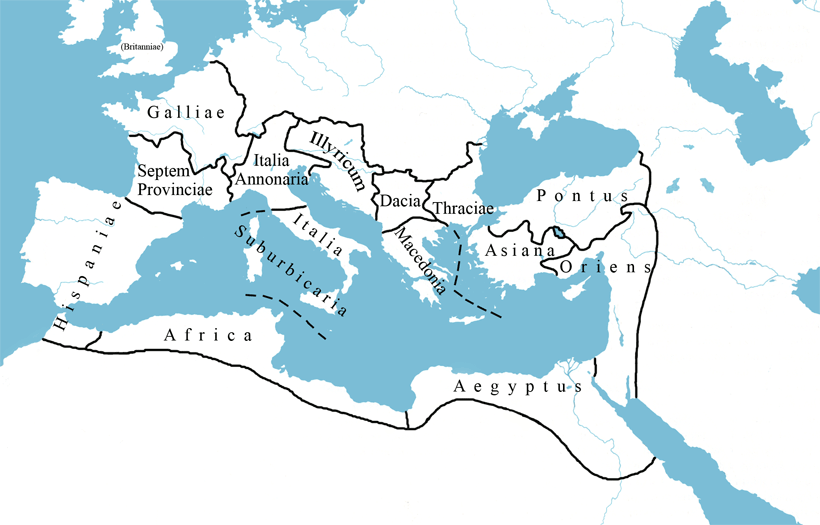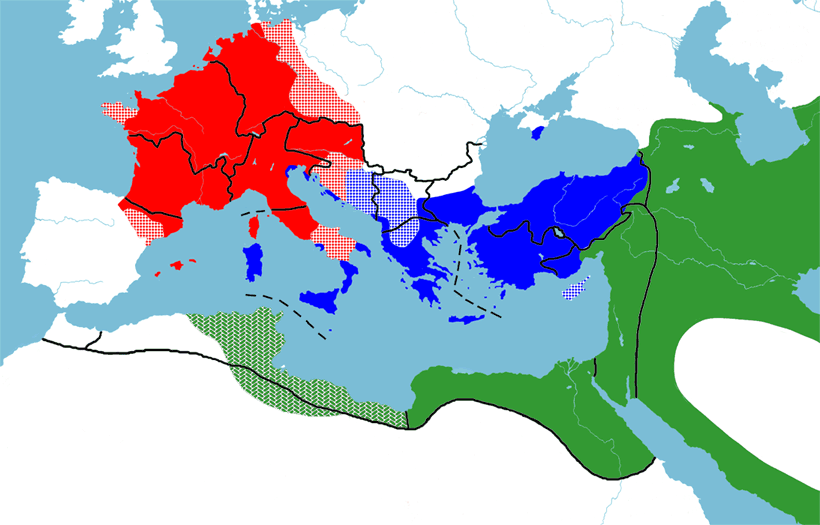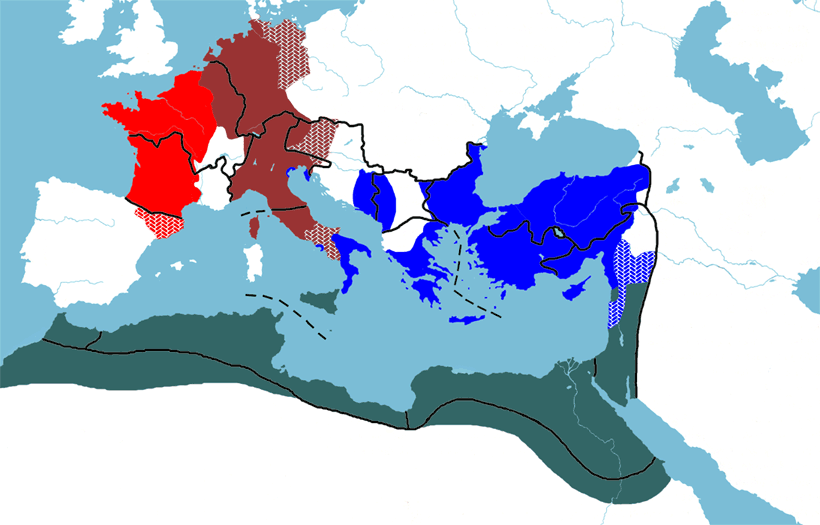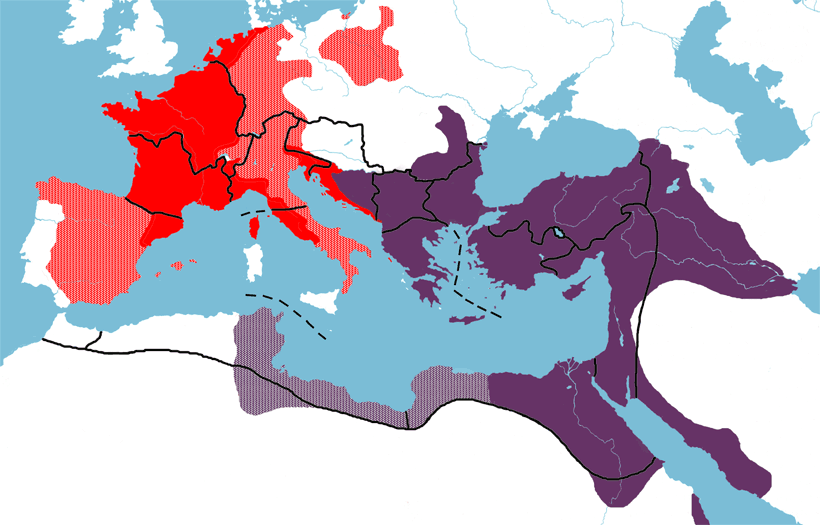Empires Strike Back
the six epochs when Imperial powers returned to dominate the
ancient lands of Rome
Last
updated: 20th September 2019.
While the Roman Empire at its height was comparable to
the contemporary Han Chinese Empire in area and population, there
is
no comparison when one looks at how many states now lie substantially
within their respective borders. For the Roman Empire the number is at
least 30, not including micro-states. For the Han Empire, it is only
two
(China and North Korea). The Chinese Empire has risen and fallen
several times over the millennia, often surpassing its extent in
classical times. By contrast, the Roman Empire was irretrievably
shattered by the events of the 5th and 6th centuries. No power has ever
reunited the ancient lands of Rome. Nevertheless
there were six epochs, since the fall of ancient Rome, when a
handful of mighty Empires shared dominion over her realms.
This page explores those six epochs and those Empires
(nine in number, with some reappearing at more than one epoch). To make
such absurdly precise claims I have of course made some arbitrary, but
mostly reasonable, definitions of terms:
- By "since the fall of ancient Rome" I mean since 536 (see here
for a
discussion).
- By "her realms" I mean the 14
continental dioceses of the Empire
in 395, the last time it had a single ruler. (That is, all the dioceses
except Britain).
- By "mighty Empires" I mean states dominating at least one, and having a
substantial presence
in at least one other, of these
14
dioceses.
- By Empires "sharing dominion over" her realms I mean that
collectively they have a substantial presence in every one of these 14 dioceses.
- By "a handful of" Empires I mean at most four.
- By "epoch" I mean a time period when the above conditions are
satisfied, and when the number
of Empires that must thereby be counted
is a local minimum.
The fourteen dioceses are shown in the map below, on the same scale
as the other maps:

The only unreasonable definition in the above is to exclude Britain
from the ancient
realms of Rome. There is some historical justification for this
omission: Britain was the last of these dioceses to be conquered (43
A.D.) and the first to be completely given up (410). But the real
reason is pragmatic: if the diocese of Britain were included, there
would be no epochs in
which all the above conditions would be satisfied. Even if "a handful"
of Empires was allowed to be five, there would only be one epoch, that around 1175,
when the Angevin
Empire ruled England and half of France, which would
make for a rather boring web page.
The six years chosen on
this web page are
relatively evenly spaced, with a maximum separation of 376 years, a
minimum of 164, and an average of 250. Not surprisingly, continuations of the Roman
Empire, in the Byzantine,
Carolingian, and Holy Roman Empires appear several times in these maps.
So do many of the "successor Empires": the
Ottoman, Hapsburg, and
Napoleonic Empires. But a number of the Empires appear nowhere else in
this site: the kingdom of France/the Franks, the Abbasid, Fatimid, and
Almohad Caliphates, and the Ayyubid Sultanate. All of the maps carry
information not found elsewhere on this site. Finally, there is a nice
symmetry in that the
number of Empires at each of these epochs goes as 2, 3, 4, 4, 3, 2.
Perhaps in the 21st century we will return to a single state governing
all of the Roman lands of old.
Note: to view these maps as a
coarse "movie", first adjust the size of
this window to be slightly larger than a map plus its title, then click
on next (>) or previous (<) at the beginning of each title. To
return
to the Index of Maps, click on the up arrow (^).
Index of Maps
561 -- 2 Mighty Empires: the
Byzantine-Roman Empire, and the Kingdom of the Franks
811 -- 3 Mighty Empires: the
Byzantine-Roman Empire, the Frankish-Roman Empire, and the Abbasid
Caliphate
975 -- 4 Mighty Empires: the
Byzantine-Roman Empire, the Holy Roman Empire, the Kingdom of France,
and the Fatimid Caliphate
1175 -- 4 Mighty Empires: the Byzantine-Roman
Empire, the Holy Roman Empire, the Almohad Caliphate, and the Ayyubid
Sultanate
1551 -- 3 Mighty Empires: the Ottoman Empire, the
Hapsburg Empire, and the Kingdom of France
1811 -- 2 Mighty Empires: the Ottoman Empire, and
the Empire of the French
^ > 561 -- 2
Mighty Empires: the Byzantine-Roman Empire, and the Kingdom of the
Franks

Prior to Justinian's wars of reconquest (533-61) in the former western
Empire,
the "Byzantine" Empire comprised the eastern 7 of the 14 continental
dioceses. The western 7 were divided among four powerful nations
(the Ostrogoths, Vandals, Visigoths, and Franks) and some lesser ones.
When Ostrogothic resistance in Italy finally ceased in 561, the Empire
had added the best parts of 3 western dioceses, and substantial parts
of another 2. Only the dioceses of Galliae
and Septimania remained
beyond Justinian's grasp, under the rule of the Franks. The Franks had
benefited from
being the first of the barbarians to covert to Orthodoxy, and from
being most distant from Constantinople. At this time the Franks had a
single king, Clothar, but his realm was divided between his sons on his
death in 561.
< ^
> 811 -- 3
Mighty Empires: the Byzantine-Roman Empire, the Frankish-Roman Empire,
and the Abbasid Caliphate

The Frankish realm was reunited twice more for short periods
under the Merovingian kings. But it far surpassed its early extent
under the succeeding dynasty, the
Carolingians: Pepin (chancellor 687-714), his son Charles Matel (Major-Domo 714-41), his son Pepin
the Great (sole ruler 743-51, king 751-68)
and his son Charles the Great (sole king 771-800, emperor 800-814).
Charlemagne's
Imperial title, bestowed upon him by the Pope, was "Emperor governing
the Roman Empire". The Byzantines however recognized him
only as Emperor of the Franks. Their own Roman Empire had begun to
decline within
three years of
Justinian's death, with the Lombard invasion of Italy in 568, and
continued almost unabated for two centuries. The greatest cause of
that decline was the rise of
the first great Muslim Empire: the Umayyad Caliphate. Between 632 and
712, it conquered the four southern dioceses of Oriens, Aegyptus, Africa, and Hispaniae (except for the extreme
north-west of the last). The Umayyad Caliphate does
not appear on this page (though see here), because one
must wait until c. 810 before the Byzantine
Empire recovered enough territory from the Slavs to have a significant
presence in all the Balkan
dioceses. By this time,
the Moslem world had been rent by a great civil war (747-756). The
Umayyads clung to power in Spain, but even there they lost the
north-east to Charlemagne (a territory just large enough to count as a
substantial presence in Hispaniae).
Elsewhere they were replaced by the Abbasid Caliphate, which however
had little interest in Africa,
losing its westernmost provinces and granting autonomy to
the Aghlabid Emirate.
In 811 a civil war began in the Abbasid Caliphate, and the Bulgars
inflicted a comprehensive defeat on the Byzantines --- Nicephorus was
the first
Roman Emperor to die in battle since Valens in 378.
< ^
> 975 -- 4
Mighty Empires: the Byzantine-Roman Empire, the Holy Roman Empire, the
Kingdom of France, and the Fatimid Caliphate

The Abbasid Caliphate declined and fragmented, in fits and starts,
until the role of Caliph was reduced to a purely spiritual one by
c.943. By this time thre was a rival Caliphate, the
Fatimids, who had replaced the Aghlabids in Africa in 909. The Fatimid Caliph
Al-Muizz (953-75) captured Cairo in
969 and Damascus in 970. The Byzantine Empire also took advantage of
Moslem disunity to advance further into Oriens than they would ever
do again. Emperor John Tzimisces, having reconquered all of Thracia from the Bulgars in 971,
retook
Damascus from the Fatimid Caliphate in 975. He planned to push onwards
to
Jerusalem, but died the next year.
Meanwhile, the Carolingian Empire had finally fallen apart in 888. The
two largest successors were the kingdoms of France (here in red)
and Germany. The reunification of the latter, under the Saxon King
Otto, with Italy as far as Rome in 962
created the Holy Roman Empire (here in maroon), with Otto as its first
Emperor. The kingdom of France
(where the Carolingian dynasty persisted) still held suzerainty over
the Catalan Counties in north-east Spain. Together with the Fatimid's
territory in Morocco, these again just
make the grade for a substantial presence in Hispaniae.
< ^
> 1175 -- 4 Mighty
Empires: the Byzantine-Roman Empire, the Holy Roman Empire, the Almohad
Caliphate, and the Ayyubid Sultanate

In 985, Lothair, the last Carolingian King of France, ignored a plea
for help from Barcelona
against the Umayyad Caliphate, and thereby lost any influence his
Kingdom had in
Hispaniae. The Umayyads gained
little, however, and from 1010 to 1031 their Caliphate was completely
shattered by civil war. From 1069, a new Islamic power arose in the African part of Hispaniae, the Almoravids. With Al-Andalus (Moslem Iberia) under dire threat from the Christian Kingdoms of northern Spain, the Andalusians invited the Almoravids to become their rulers, and they completed their take over by 1115.
But they grew soft and were overthrown by their rivals, the Almohads, in their Moroccan heartland in the 1140s, and in Al-Andalus by 1172. The Almohads also conquered the whole of Africa by 1160, with little
resistance by the Fatimids. For the Fatimids, like the Abbasids before them, had allowed
their western territories to slip into independence. The remnant
Fatimid Caliphate in Egypt was
attacked by both Crusaders and the Zangids, a Turkish people, but the
latter emerged victorious in 1169. The Zangid ruler, Nureddin, was
succeeded in 1174 by his famous Kurdish general Saladin, who founded
the Ayyubid Sultanate.
The Byzantines had, by this time, recovered somewhat
(with help from the Crusaders) from a disastrous defeat by the Turks in
1071. But they soon after suffered another crushing defeat by the Seljuk
Turks at Myrocephalum in 1176. In the same year, the Holy Roman
Emperor, Frederick Barbarossa, was defeated by the forces of the league
of Lombard cities within his own territory in Italia Annonaria.
< ^
> 1551 -- 3 Mighty Empires:
the Ottoman Empire,
the Hapsburg Empire, and the Kingdom of France

The hollowness of the Holy Roman Empire was fully exposed when the
Papal States (including Rome) seceded in 1278. The Byzantine Empire had
fallen more
dramatically in 1204, when Constantinople was sacked by Crusaders. In
1212, the Almohad Caliphate abandoned
Spain following a devastating defeat
at the hands of a Christian coalition there, and by 1269 had ceased to
exist. In the Mediterranean region, the age of Mighty Empires seemed
over, except in the east where the
Mamluke Sultanate had supplanted the Ayyubid Sultanate, and now held
the line against the Mongol
Khanates.
The Mamlukes,
like the Zangids who had preceded the Ayyubids, were a Turkish people,
and had been warrior-slaves under the Ayyubids. The Mamluke Sultanate
was
finally conquered by the Ottomans, another Turkish people, in 1516-7.
By this time the Ottoman Empire had also eliminated the feeble remnants
of the Byzantine Empire (giving Constantinople its second sack in 1453)
and conquered almost the whole of the 7 eastern dioceses. Continuing
this seemingly unstoppable expansion, the Ottoman Sultan Suleiman the
Magnificent (1520-66) went on to capture
much of
Hungary by 1538, and most of Africa
by 1551. At this time, a worthy Christian rival had finally arisen: the
Hapsburg King Charles V of Spain (1516-56), the last Holy Roman Emperor
to be crowned by the Pope. The title itself held little significance,
but Charles' power in Spain, Austria, Italy, the Netherlands, and the
New World, was very real indeed. He had inherited most of his
territories through various accidents, and needed all his resources and
wits to protect them from the Ottomans and their oft-time ally, the
Kingdom of France. The latter had only recently emerged, under Francis
I (1515-47), from its feudal
period of provincial autonomy. Francis' successor Henry II renewed the
war against the
Hapsburgs in 1551, allied with Charles' nominal subjects, the
Protestant Princes of the Holy Roman Empire, and had some early
successes. Charles V abdicated in 1556, dividing his Empire between his
brother (Austria and the Imperial title) and his son (Spain and
everything else).
< ^
1811 -- 2 Mighty
Empires: the Ottoman Empire, and the Empire of the French

France, the Ottoman Empire, and the Austrian and Spanish Hapsburgs
continued to
dominate the once-Roman lands, until the war of the Spanish succession
and its aftermath (1701-20). This resulted in the Austrian Hapsburgs
taking over the
scattered European territories of Spain (now under a Bourbon King),
confining it to Hispaniae.
But by 1735 the
Austrians had lost the Kingdom of Naples, and with it their presence in
Italia Suburbicaria. It was
left to Napoleon, Emperor of the French (1804-14), to recreate a
western Empire to rival the Ottomans. His Empire reached its peak in
1811, but fell to nothing (outside France) within a few years,
following his catastrophic invasion of Russia in 1812. The Ottoman
Empire, meanwhile, was well past its peak by this time, but remarkably
continued to dominate the 7 eastern dioceses, and have a substantial
presence in
another 2 (Africa and Illyria), until 1878. Its
continuation, the Turkish republic (1923-),
still occupies 2 (Pontus and Asiana) and has a substantial
presence in another 2 (Thraciae
and Oriens). While Britain,
France and Italy built overseas Empires in former Ottoman lands, and
Germany
and Italy conquered
vast areas in Europe in the 2nd World War, Hispania always remained under the
control of the minor powers of Spain and Portugal. Even if we were to
regard the European Union (which has included Spain and Portugal since
its formation in 1993) as an Empire, there has been no substantial
presence of any "Mighty Empire'' in the diocese of Africa since the French withdrew in
1962. Thus there is
yet to
be a seventh epoch when a
handful of mighty Empires shared dominion over the former lands of the
Roman Empire.
Return to the Roman Empire main
page






